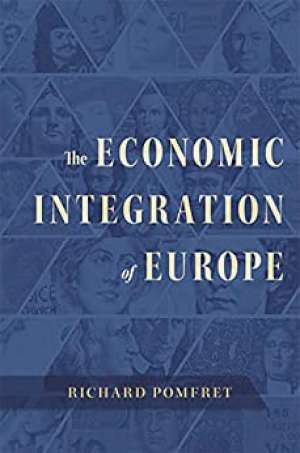28 March 2022
The Economic Integration of Europe
Richard Pomfret
2022, Harvard University Press, 272 pages,
ISBN 9780674244139
Reviewer: Vicky Pryce

I was reminded reading this very timely book that before the ‘Global Britain’ concept was coined by the Brexiteers post the UK referendum vote to leave the EU in 2016, the EU had already developed its ‘Global Europe’ programme. That meant more trade with the rest of the world, opening up to competition from abroad, cutting tariffs under new trade deals with countries and regions further afield, opening up to more investment and procurement. That has reflected a new belief that it is that way, rather than through ‘fortress Europe’, that European competitiveness would be encouraged. Of course the UK, in its own pursuit for ‘global reach’, perversely withdrew from the close relationship with Europe , its close geographical neighbour. But this is, of course, another story..
European economic integration and the process to it is what this book is about, including in the pursuit of widening its territory and its horizons and ambitions. The path has not always been smooth – look for example at the ructions caused by the UK’s exit. It is also true that at times the enlargement was brought about too fast because of the force of circumstances such as the fall of the Berlin Wall and the end – for what looked permanent but now is once again questionable – of the Soviet Union. The newer countries at time felt excluded or worried that their interests were being ignored – as we saw with the Syrian migration crisis. And the brutal way with which stronger nations such as Germany but also the Netherlands, for example, dictated policies in weaker countries, particularly in Southern Europe, during the Eurozone crisis has left its scars.
After the original six set up the European Coal and Steel Community at the end of the second World War, integration proceeded at pace with the eventual emergence of a customs union, a European Economic Community and then the emergence the EU with a parliament, elected representatives and a political structure linking national parliaments to the Council of Ministers and decisions and legislation pushed through by the European Commission. The adoption of the single market in January 1993 allowed the free movement of people, capital and goods and services among the 28 (not 27) member states.
That made it a market of some 550m people though countries still differed – and continue to differ – in economic performance. Cohesion funds redistributed from the various countries’ annual budget contributions are targeted to regions that lag behind, most recently the new joiners from the former Eastern European countries receiving the bulk of the money. Meanwhile EU- funded transport infrastructure has been instrumental in improving connectivity and encouraging economic welfare across the region and bringing countries closer together.
Additionally, of course, the last capital movement impediments inherent in different and volatile currencies were eliminated for the 19 countries now that have adopted the Euro as their common currency.
As Richard Pomfret explains, there have been periods whenthat integration looked under threat, particularly during the aftermath of the financial crisis. But the path toward greater economic integration has continued. Examples include the banking union, moves toward a single digital and energy market , a determined combined EU plan towards achieving net zero, cross-EU labour market legislation such as the working time and agency worker directive, and European Commission legislation in the area of gender equality intended to be superimposed over national governments efforts .
To this should be added the acceptance of shared risk finally in the issuing of Euro green bonds; scientific collaboration through the Horizon programmes; educational exchanges – Erasmus etc; and a strategy for “Smart, Sustainable and Inclusive growth”, adopted by the EU in 2020, even before extra support and emergency measures were put in place to deal with the Covid pandemic.
Not all has, of course, gone according to plan. And political integration has proceeded more slowly. Relationship with the US has had its ups and downs but at least we have just seen the elimination of the aluminium and steel tariffs imposed on the EU by President Trump and the reciprocal lifting of extra tariffs on some US imports by the EU. There have been issues of the perceived erosion of democracy in Poland and Hungary. And there are different views about opening up to the Western Balkans and beyond with Croatia the only country from that region to have joined the club – though, again, the EU had moved closer to some like the Ukraine and Moldova before the Russian invasion. And, interestingly, some 17 countries, from Greece up to the Baltic States, have formed an Eastern group to promote their own interests which some EU countries consider as a threat to unity and European integration.
The region of course has recently been tested, by Covid and the Ukraine crisis. It will continue to be tested while the standoff with Russia continues. And though as the book says it is difficult to estimate the economic counterfactual of non-integration as we look across the decades of closer economic ties, a divided Europe would have certainly fared a lot worse, both politically and economically in the last two years since Covid first hit in early 2020.
